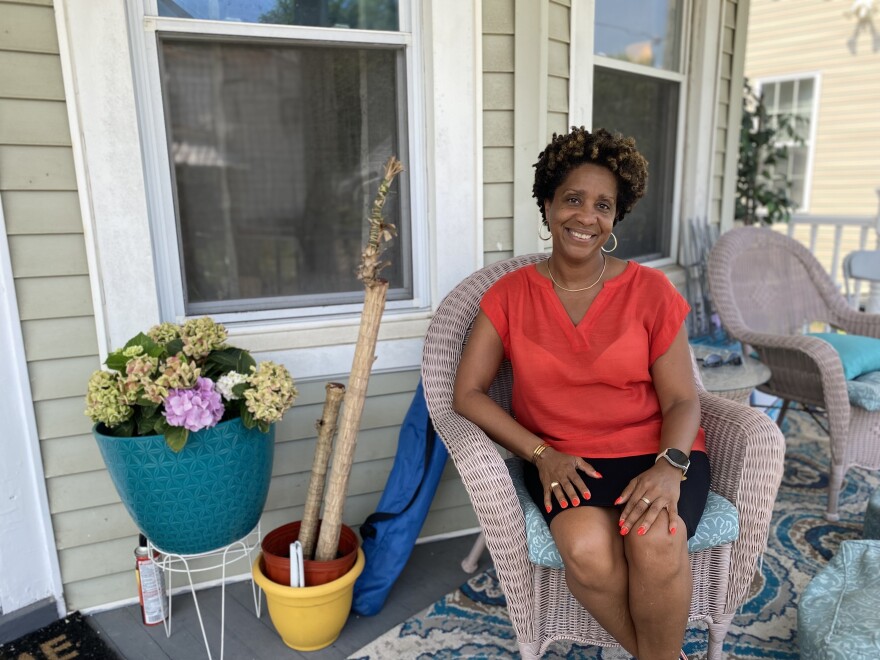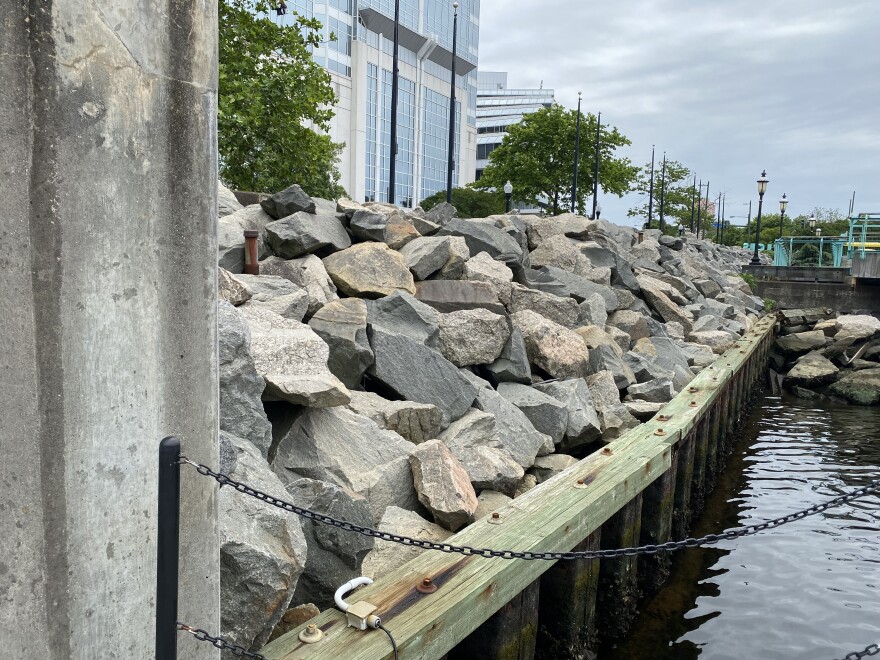Kim Sudderth loves the "porch culture" of Norfolk's tight-knit Berkley area.
She's lived in the historically Black neighborhood for five years, and knows the names of almost everyone on her block. They often wave to each other over morning coffee.
The community dates back to shortly after the Civil War, and many of the houses — including Sudderth's — are at least a century old. Residents cherish the strong sense of history and community.
But there's a downside: Many of the neighborhood's streets flood just about every time it rains.
"It's kind of a way of life," Sudderth said. "We're doing our best to work with the water."

On a recent muggy morning, she pointed to the evidence on her street corner: standing water still pooled from a downpour a few days prior. On rainy days, she said, the flooding can be bad enough that someone might lose their car.
That kind of flooding disrupts life all over Norfolk during rainstorms or even high tides — swamping intersections, ruining cars and cutting some neighborhoods off from the rest of the city. Climate change is making the problem worse. Sea levels are rising faster in Norfolk than anywhere else on the East Coast, driven by a combination of warming oceans and sinking land in the region.
The city is now moving forward with a massive floodwall project to protect itself, in partnership with the U.S. Army Corps of Engineers. The project will include tide gates, levees, pump stations and nature-based features like oyster reefs and vegetation along the shoreline. It's one of the biggest infrastructure efforts in city history — and an example of projects the Corps has proposed up and down the U.S. coastline, from New York to Texas.
But the $2.6 billion project largely won't protect neighborhoods like Sudderth's from the regular flooding it already experiences.
Instead, the project is meant to shield the city from a catastrophic storm. It specifically targets storm surge, the abnormal rush of water generated during major storms like hurricanes.
"We should call it the catastrophe wall or the hurricane wall, because floodwall is kind of a misleading statement," said Jay Ford, Virginia policy advisor with the Chesapeake Bay Foundation.
The nonprofit is one of several local groups reluctantly fighting the project.
While Ford and other critics agree that major storms pose a serious threat to the city, they argue it's shortsighted to spend billions of dollars on a project that doesn't address existing flooding — especially because that flooding is expected to worsen as climate change drives more intense rain and higher sea levels.
"For a lot of folks in Hampton Roads, sea level rise means the sun is out and you're just trying to get your kid to school but for some reason there is a completely flooded road," Ford said. "This project won't do anything to alleviate that."

Sudderth and her neighbors have another concern: The original floodwall design didn't reach several majority-Black communities across from downtown Norfolk along the Elizabeth River — including Berkley.
"We're going to be left out," Sudderth said she thought when she first learned about the plan.
Critics say the project exemplifies flaws in how the federal government approaches major flood infrastructure.
And the debates happening in Norfolk are an example of conversations that will increasingly play out across the nation, as climate change imposes major new costs on coastal communities, said Rob Young, a geologist who studies coastal engineering at Western Carolina University.
Local officials need to think hard about how to prioritize limited resources, Young said: "We know we don't have all the money in the world."
For their part, city officials see the floodwall project as a "once in a lifetime opportunity" for Norfolk to protect itself.
Congress recently earmarked $400 million for the project in the 2021 Bipartisan Infrastructure Law. If the city doesn't take advantage of that federal funding, it could lose its opportunity — and a major hurricane could be disastrous, said Kyle Spencer, the city's chief resilience officer.
"The cost of not doing this is far, far greater than the cost of doing it," Spencer said.
Preventing another Superstorm Sandy
Norfolk City Councilmember Andria McClellan worries about the regular flooding — including in her own neighborhood. But she worries about something else even more.
"Every hurricane season that comes through, I worry that this is going to be the one," McClellan said, noting that just one massive storm could devastate the city. "These projects take decades to complete. If we don't start now, we're never going to be ready."
Norfolk's floodwall project is one of many the Army Corps proposed after Hurricane Sandy tore through communities along the East Coast in 2012, causing $65 billion in damage and killing more than 100 people.
It was a wake-up call for the Corps, which has long overseen major flood control projects across the country. Congress directed the agency to study how it could protect coastal communities from the next Sandy.
Michelle Hamor, planning and policy chief with the Corps' Norfolk District, said officials identified areas most at risk from major storms, including Norfolk.
The Corps targeted regions that could experience the costliest damage to homes and businesses, and would benefit from a floodwall-style project.
"We want to tangibly reduce risk," Hamor said. "So, we want to focus on those high priority areas where the damage is greatest or repetitive."

The agency's task isn't to stop all flooding, Hamor said. It's to prevent the kind of severe damage to structures that Sandy caused — largely as calculated in dollars.
In other words, under the Corps' formula, the more expensive the damage that a project can prevent, the more that project is worth doing.
That means projects are more likely to protect areas with high property values, said Young with Western Carolina University.
"If your real estate is not worth a lot of money, then the Corps can't protect you," Young said. "It's as if the only thing we value as Americans when we're spending federal money is value. And that's really unfortunate and really problematic."
That's part of the problem in Norfolk, said Sudderth.
Shortly before the City Council was set to approve the floodwall agreement earlier this year, residents of several majority-Black and lower-income neighborhoods on the city's Southside learned the floodwall would not extend to them.
Instead, the Corps proposed to work with homeowners to raise homes and fill in basements.
Sudderth, who sits on the city's planning commission, said the communities left out are among those that were historically discriminated against through practices like redlining, in which banks and governments refused to invest in communities of color.
She felt like history was repeating itself.
"It struck me, like, 'Oh my God, it's happening again.' And this time it's happening to me," Sudderth said, with an incredulous laugh. "It's 2023, and it's still happening."
She and dozens of other residents pushed back — and local leaders listened.
The city and the Corps' Norfolk District have asked for federal permission to change the plan and possibly include flood protection structures in the southern part of the city, according to district spokesperson Mark Haviland, who called such a change "unprecedented."
Congress would have to approve any changes.
A floodwall that doesn't solve flooding
Critics say the current approach can also steer the Corps toward a focus on big projects to prevent big disasters, overlooking the slower, creeping costs of climate change. That includes so-called sunny day flooding from rising seas, as well as flash flooding from heavy rain.
The full Norfolk floodwall project is estimated to cost $2.6 billion. The federal government has committed to covering 65% of the total cost. But even with that contribution, city officials acknowledge their funding obligations will be daunting. Norfolk will be responsible for $931 million, which it hopes to split with the state.

That rings alarm bells for Skip Stiles, who recently retired as longtime head of the Norfolk nonprofit Wetlands Watch. He's spent years working to get local officials to take regular flooding seriously, and worries the cost of the floodwall will make it even harder for the city to take action.
"I'm someone who lives in Norfolk and has to deal with flooding," he said. "And if I, as a taxpayer in Norfolk, am going to be paying the $900 million local and state share of this, I want protection from flooding."
The city of Norfolk acknowledges that finding the money for the floodwall project could delay some planned work to address existing flooding.
Critics have raised the issue with the Army Corps nationwide.
In 2021, the national advocacy group Environmental Defense Fund sent a letter to the Corps, expressing similar concerns about the agency's flood protection projects. It argued an approach "that focuses solely on hurricane storm surge is short-sighted and leaves millions of Americans exposed to current and future chronic flood risk."
Norfolk residents often assume the floodwall is designed to address their daily flooding problems, Stiles said.
"When they're told that it's not, they go, 'Oh, OK, what's the plan for the rest of it?'" he said. "And that's when the blank stares happen."
Stiles said he's glad the city and Army Corps are planning ahead for catastrophic storms. But he wishes they would also focus on what he sees as an equally existential threat.
It feels, he said, like "the Corps said, 'you want to protect yourselves against the rest of the flooding? That's on you."
Copyright 2023 NPR. To see more, visit https://www.npr.org.


